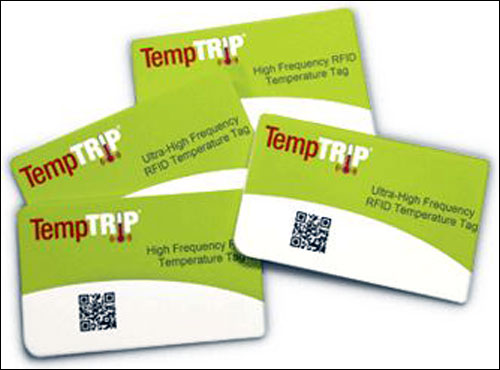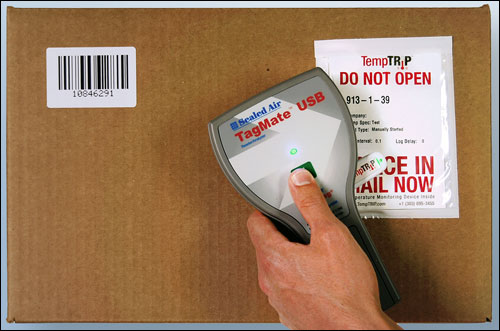Globally, food waste is a major economic and environmental problem. A 2009 study conducted by the U.S. National Institutes of Health found that up to 40 percent of food in the United States is wasted due to a number of factors, including exposure to unsafe temperatures as the food travels from farms to stores or restaurants. This leads to billions of dollars in annual losses for producers and retailers alike.
“If a grocer turns away an entire truckload of strawberries due to spoilage, that’s a $40,000 loss,” says Michael McCartney, founder and principal at QLM Consulting, an RFID consulting firm serving the food industry (see A Guide to Sensor-Equipped RFID Tags).

TempTrip, a two-year-old joint venture between Sealed Air, a New Jersey-based provider of food and protective packaging products, and Results Oriented Inc., a software integrator and consultancy based in Colorado, believe that RFID sensors and software can resolve this issue.
To help producers and shippers identify chronic problems in their supply chains, TempTrip has launched a temperature-tracking and software platform designed to simplify the monitoring of the conditions to which perishable or temperature-sensitive cargo is subjected during transit.
In the course of its research of the cold-chain logistics industry, says Lee Curkendall, TempTrip’s chief technology officer, the Broomfield, Colo.-based company found that although many producers and shippers were using non-RFID electronic temperature-tracking devices to monitor the temperatures to which shipments were exposed during transit, the processes by which they collected the data from these devices were labor-intensive, and not appreciably simpler than using older, mechanical equipment.
“We found that modern electronic loggers were still being used in the same manner as the old mechanical devices, but the way they’re used actually adds steps without taking advantage of the digital data,” Curkendall says. “Instead of reviewing a paper strip chart from a mechanical logger, which would show whether the temperatures exceeded the set threshold, the user would take the electronic logger to a computer, download the results with local software and print the results on a computer printer.”TempTrip’s RFID-enabled digital temperature-trackers eliminate the need to handle each device, the company reports, and allows a user to wirelessly collect the temperature logs from each tag, using an RFID reader and Web-based software. The device provides temperature-tracking tags and readers to producers and shippers of food and perishable drugs. These customers can order the tags online, and have them set with the temperature thresholds appropriate for the particular items they are shipping.
End users have the option of sending the tags back to TempTrip after the shipment in which they are placed is received at its final destination. Upon receiving the tags, TempTrip will collect the tag data and upload it to the firm’s Web-based software platform. End users will then be able to access this information by logging onto TempTrip’s Web site. From there, they can analyze the data, and view the results in a number of graphical formats, as well as overlaid on maps showing the points at which a shipment’s temperature fell into or near unsafe levels. The software can also pull associated data, such as shipment orders or billing information, from a customer’s enterprise software. Alternately, the customer can use TempTrip’s application programming interfaces (APIs) to pull the data and analysis into its enterprise software.

Customers can also opt to order both the tags and an RFID reader. If a customer chooses this option, it can associate each tag with a shipment by scanning a bar code—for instance, the code used to identify the order in its enterprise resource planning (ERP) system, or the one that utilized by FedEx or a third-party shipper to track the order—and then reading the RFID tag. This association between tag number and order data is saved to the reader, and is later uploaded to the TempTrip software.
The user can download the data collected on the TempTrip reader in one of three ways. The information can be collected wirelessly, via a Wi-Fi Internet connection or a cellular link to TempTrip’s server, or it can be downloaded via a USB thumb drive included with the reader. The thumb drive contains a small application that uploads the data to the user’s TempTrip Web account.
Once the shipment is received, the receiver—also outfitted with the TempTrip reader—would interrogate each tag using the reader. With each tag read, the tag number and the temperature data is collected. If the end user is wirelessly uploading the tag data to the TempTrip software as the shipment is received, the software can issue an alert via e-mail or text message if any tag shows a temperature outside the product’s safe range.
“All tag functions are controlled by the reader,” Curkendall says. This includes scanning the bar code used to correlate the tags with a shipment, downloading the temperature logs from the tags, and clearing the logs from the tags once they’re downloaded.Regardless of whether the end user is utilizing a TempTrip reader to collect the data from the tags, or using TempTrip’s service to download the information from the Internet, the customer can return the tags to the company in a self-addressed mailer that TempTrip provides.
“The tags come back to us in a Netflix-like model,” Curkendall explains, referring to the movie-rental service that enables users to rent DVDs online and return them in a prepaid envelope via U.S. mail. When customers opt to mail the temperature loggers back to TempTrip, the results are generally available online within 48 hours.
TempTrip designs its own RFID tags and handheld readers in-house, and outsources production to a Chinese contract manufacturer. The firm currently offers a 13.56 MHz battery-assisted passive RFID tag housed in a plastic card (like a credit card), and compliant with the ISO 15693 standard. Though the tag number and temperature data are read passively, using backscatter, an onboard battery runs the processor, as well as the temperature sensor and logger. The tags can store up to 700 temperature and time records, and up to 10,000 alarm messages, which the tag triggers when it is exposed to a temperature outside its safe range. A user can specify the rate at which the tag will be set to collect this information, Curkendall says, noting that it is most often set to collect every 15 minutes.
Additionally, TempTrip has designed a version compliant with the EPC Gen 2 standard for ultrahigh-frequency (UHF) tags, though that model is not yet available.
Because Results Oriented Inc. worked with several companies in the cold supply chain—both food and pharmaceutical firms—before forming the joint venture, TempTrip already had a client base when it launched. “We have targeted and are selling to companies that are in the multi-billion-dollar revenue category,” Curkendall states, “but we also sell to a few in the sub-$50-million category. We do short pilots, usually paid by the customer, for a customer to trial the product.”

